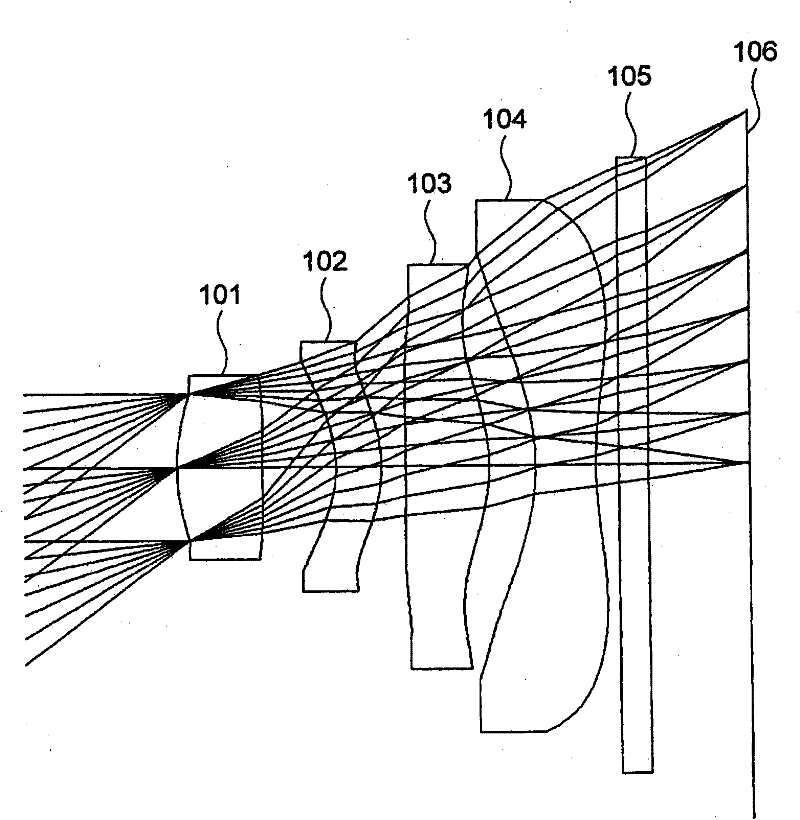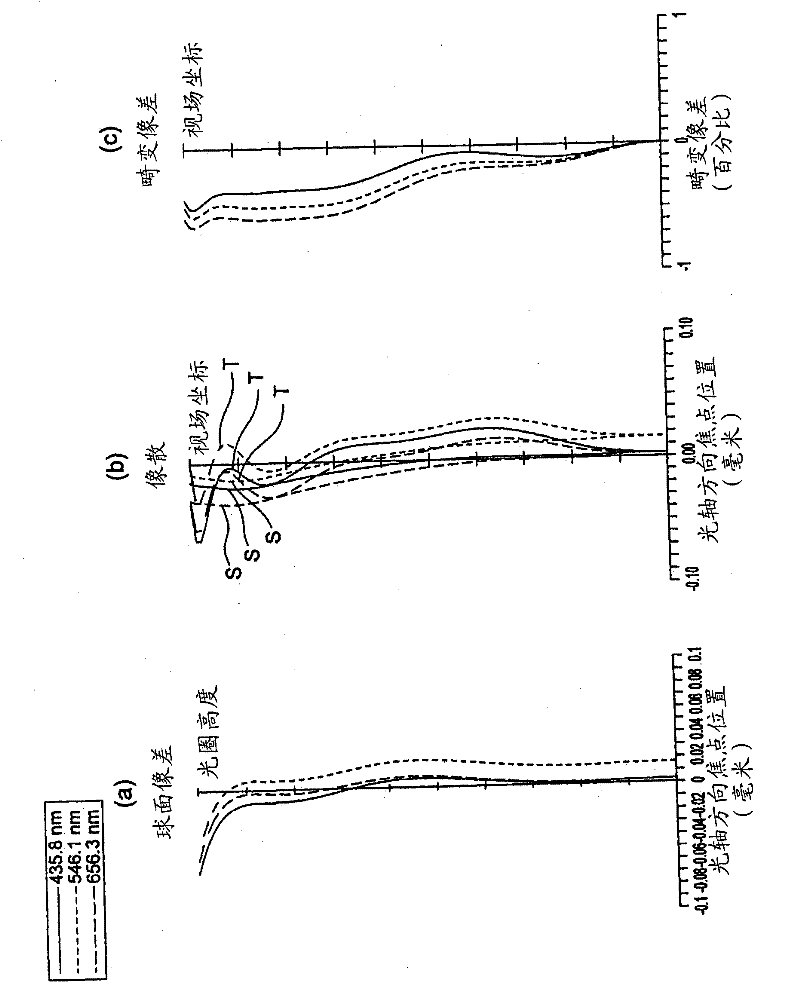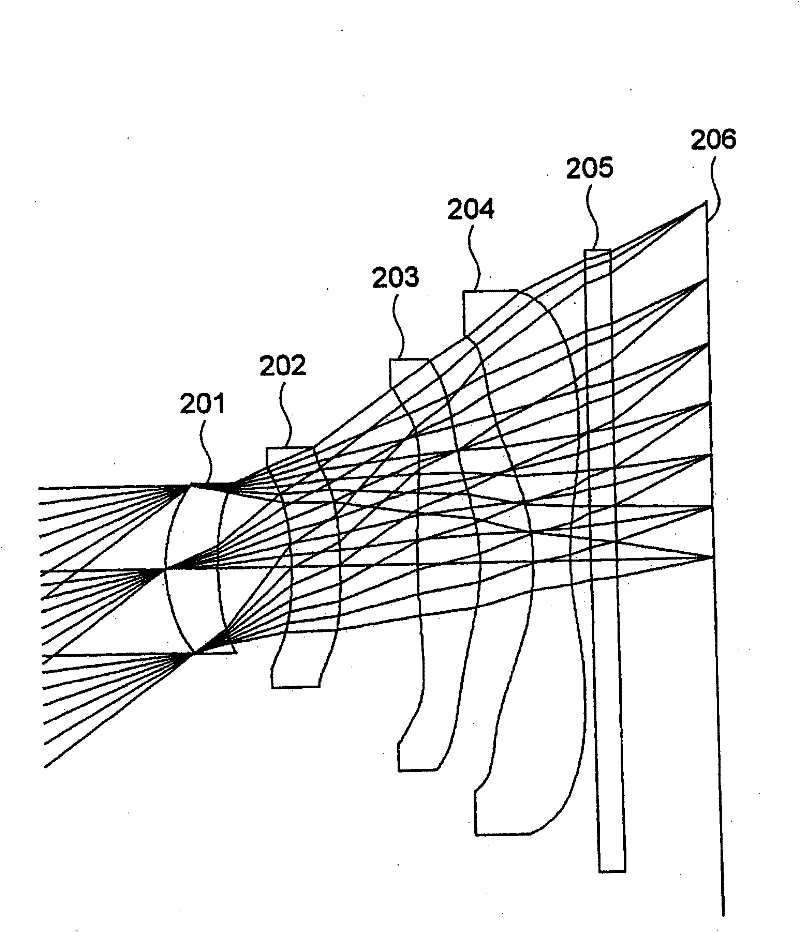Imaging optical system
A technology of imaging optics and image plane side, which is applied in optics, optical elements, diffraction gratings, etc., can solve the problems of image deterioration, processing and assembly time, and yield decline, etc., and achieve the effect of compact imaging optical system
- Summary
- Abstract
- Description
- Claims
- Application Information
AI Technical Summary
Problems solved by technology
Method used
Image
Examples
Embodiment 1
[0083] figure 1 It is a figure which shows the structure of the imaging optical system of Example 1. The imaging optical system of Example 1 includes a first lens 101 , a second lens 102 , a third lens 103 , and a fourth lens 104 from the object side to the image side. The diaphragm is closer to the object side than the image-side surface of the first lens 101 , and is closer to the image side than the apex of the object-side surface of the first lens 101 . Specifically, the aperture is located on the object-side surface of the first lens 101 . The light passing through the first lens 101 , the second lens 102 , the third lens 103 , and the fourth lens 104 passes through the glass plate 105 and reaches the image plane 106 .
[0084] In this embodiment, a diffraction grating for decolorization is provided on the image plane side of the first lens. In this embodiment, the achromatic function is mainly performed by a diffraction grating, and the number of zones of the diffract...
Embodiment 2
[0102] image 3 It is a figure which shows the structure of the imaging optical system of Example 2. The imaging optical system of Example 2 includes a first lens 201 , a second lens 202 , a third lens 203 , and a fourth lens 204 from the object side to the image side. The diaphragm is closer to the object side than the image-side surface of the first lens 201 , and is closer to the image side than the apex of the object-side surface of the first lens 201 . Specifically, the aperture is located on the object-side surface of the first lens 201 . The light passing through the first lens 201 , the second lens 202 , the third lens 203 , and the fourth lens 204 passes through the glass plate 205 and reaches the image plane 206 .
[0103] In this embodiment, a diffraction grating for decolorization is provided on the image plane side of the first lens. In this embodiment, the achromatic function is mainly undertaken by the diffraction grating, and the number of zones of the diffr...
Embodiment 3
[0121] Figure 5 It is a figure which shows the structure of the imaging optical system of Example 3. The imaging optical system of Example 3 includes a first lens 301 , a second lens 302 , a third lens 303 , and a fourth lens 304 from the object side to the image side. The diaphragm is closer to the object side than the image-side surface of the first lens 301 , and is closer to the image side than the apex of the object-side surface of the first lens 301 . Specifically, the aperture is located on the object-side surface of the first lens 301 . The light passing through the first lens 301 , the second lens 302 , the third lens 303 , and the fourth lens 304 passes through the glass plate 305 and reaches the image plane 306 .
[0122] In this embodiment, a diffraction grating for decolorization is provided on the image plane side of the first lens. In this embodiment, the achromatic function is mainly performed by a diffraction grating, and the number of zones of the diffrac...
PUM
 Login to View More
Login to View More Abstract
Description
Claims
Application Information
 Login to View More
Login to View More - R&D
- Intellectual Property
- Life Sciences
- Materials
- Tech Scout
- Unparalleled Data Quality
- Higher Quality Content
- 60% Fewer Hallucinations
Browse by: Latest US Patents, China's latest patents, Technical Efficacy Thesaurus, Application Domain, Technology Topic, Popular Technical Reports.
© 2025 PatSnap. All rights reserved.Legal|Privacy policy|Modern Slavery Act Transparency Statement|Sitemap|About US| Contact US: help@patsnap.com



